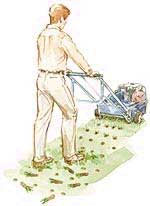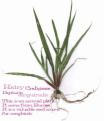
If your lawn sees heavy traffic, kids playing, family gatherings, and the like, it could be suffering, to some degree, from soil compaction.
Compaction causes soil to lose its fluffy texture, keeps air and water out, and makes it tough for grass roots to grow.
Annual Core Aeration is beneficial for most lawns.
Lawns growing on heavy clay or sub-soils, and lawns exposed to intense use, benefit from more than one aeration each year. In general, benefits from core aeration increase when tine spacing is closer and penetration is deeper. Most turf grasses respond favorably to aeration, when properly timed.
Both spring and fall are ideal times to aerate cool season turf grass, such as Kentucky bluegrass and perennial ryegrass. In most cases, spring aeration is performed between March and May, depending on location, turf grass species, and intensity of use. Fall aeration is done in late summer and early fall, usually between August and November. Aeration before, or at the time of late season
fertilization, enhances root growth responses and improves spring green-up and growth.
It is best to aerate warm season turf grasses such as Zoysia grass and Bermuda grass in mid-spring to summer. Avoid aerating when warm season grasses are dormant. This may encourage cool season weed competition. In addition, avoid aerating warm season grasses during spring green-up. It is best not to aerate warm season lawns until after they have received their first mowing in spring.

Although aeration is beneficial for lawns, it also can open up spaces for weeds, such as
crabgrass and annual bluegrass to invade the lawn. It is best to aerate before you apply pre-emergence herbicides, rather than after. Aerating after a
herbicide application can reduce the chemical barrier formed by the herbicide, thereby allowing some weeds to germinate and grow in the lawn. Applying fertilizer after aeration helps the lawn compete against weeds. Water the lawn after aeration, particularly in areas where drought and high temperatures are common.
Enter our, ever evolving,
Garden Center now!!
 If your lawn sees heavy traffic, kids playing, family gatherings, and the like, it could be suffering, to some degree, from soil compaction.
Compaction causes soil to lose its fluffy texture, keeps air and water out, and makes it tough for grass roots to grow. Annual Core Aeration is beneficial for most lawns.
Lawns growing on heavy clay or sub-soils, and lawns exposed to intense use, benefit from more than one aeration each year. In general, benefits from core aeration increase when tine spacing is closer and penetration is deeper. Most turf grasses respond favorably to aeration, when properly timed.
Both spring and fall are ideal times to aerate cool season turf grass, such as Kentucky bluegrass and perennial ryegrass. In most cases, spring aeration is performed between March and May, depending on location, turf grass species, and intensity of use. Fall aeration is done in late summer and early fall, usually between August and November. Aeration before, or at the time of late season fertilization, enhances root growth responses and improves spring green-up and growth.
It is best to aerate warm season turf grasses such as Zoysia grass and Bermuda grass in mid-spring to summer. Avoid aerating when warm season grasses are dormant. This may encourage cool season weed competition. In addition, avoid aerating warm season grasses during spring green-up. It is best not to aerate warm season lawns until after they have received their first mowing in spring.
If your lawn sees heavy traffic, kids playing, family gatherings, and the like, it could be suffering, to some degree, from soil compaction.
Compaction causes soil to lose its fluffy texture, keeps air and water out, and makes it tough for grass roots to grow. Annual Core Aeration is beneficial for most lawns.
Lawns growing on heavy clay or sub-soils, and lawns exposed to intense use, benefit from more than one aeration each year. In general, benefits from core aeration increase when tine spacing is closer and penetration is deeper. Most turf grasses respond favorably to aeration, when properly timed.
Both spring and fall are ideal times to aerate cool season turf grass, such as Kentucky bluegrass and perennial ryegrass. In most cases, spring aeration is performed between March and May, depending on location, turf grass species, and intensity of use. Fall aeration is done in late summer and early fall, usually between August and November. Aeration before, or at the time of late season fertilization, enhances root growth responses and improves spring green-up and growth.
It is best to aerate warm season turf grasses such as Zoysia grass and Bermuda grass in mid-spring to summer. Avoid aerating when warm season grasses are dormant. This may encourage cool season weed competition. In addition, avoid aerating warm season grasses during spring green-up. It is best not to aerate warm season lawns until after they have received their first mowing in spring.
 Although aeration is beneficial for lawns, it also can open up spaces for weeds, such as crabgrass and annual bluegrass to invade the lawn. It is best to aerate before you apply pre-emergence herbicides, rather than after. Aerating after a herbicide application can reduce the chemical barrier formed by the herbicide, thereby allowing some weeds to germinate and grow in the lawn. Applying fertilizer after aeration helps the lawn compete against weeds. Water the lawn after aeration, particularly in areas where drought and high temperatures are common.
Enter our, ever evolving, Garden Center now!!
Although aeration is beneficial for lawns, it also can open up spaces for weeds, such as crabgrass and annual bluegrass to invade the lawn. It is best to aerate before you apply pre-emergence herbicides, rather than after. Aerating after a herbicide application can reduce the chemical barrier formed by the herbicide, thereby allowing some weeds to germinate and grow in the lawn. Applying fertilizer after aeration helps the lawn compete against weeds. Water the lawn after aeration, particularly in areas where drought and high temperatures are common.
Enter our, ever evolving, Garden Center now!!


No comments:
Post a Comment